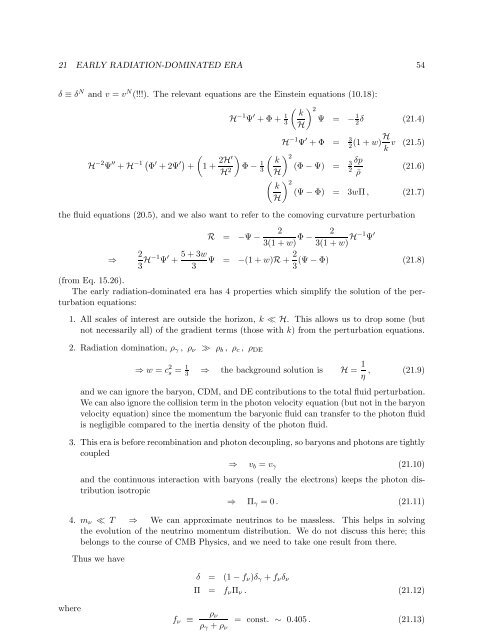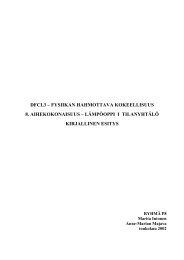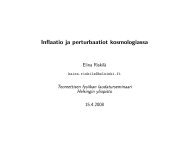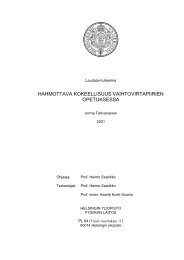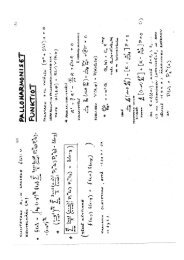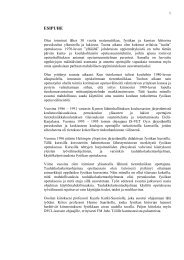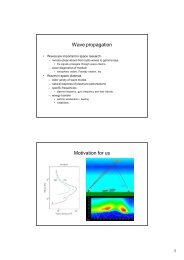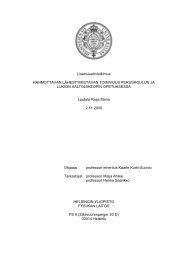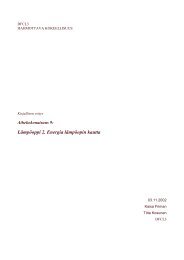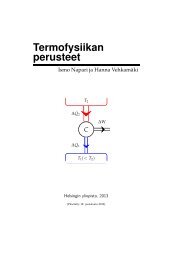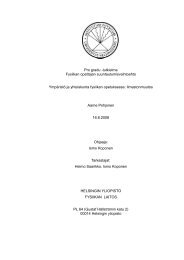Cosmological Perturbation Theory, 26.4.2011 version
Cosmological Perturbation Theory, 26.4.2011 version
Cosmological Perturbation Theory, 26.4.2011 version
You also want an ePaper? Increase the reach of your titles
YUMPU automatically turns print PDFs into web optimized ePapers that Google loves.
21 EARLY RADIATION-DOMINATED ERA 54δ ≡ δ N and v = v N (!!!). The relevant equations are the Einstein equations (10.18):( ) k 2H −1 Ψ ′ + Φ + 1 3Ψ = − 1H2 δ (21.4)H −1 Ψ ′ + Φ = 3 2 (1 + w)H k v (21.5)H −2 Ψ ′′ + H −1 ( Φ ′ + 2Ψ ′) (+(1 + 2H′ k 2 )ΦH 2 − 1 3(Φ − Ψ) =H) 3 δp2¯ρ( ) k 2(Ψ − Φ) = 3wΠ, (21.7)H(21.6)the fluid equations (20.5), and we also want to refer to the comoving curvature perturbation⇒2R = −Ψ −3(1 + w) Φ − 23(1 + w) H−1 Ψ ′23 H−1 Ψ ′ + 5 + 3w Ψ = −(1 + w)R + 2 (Ψ − Φ) (21.8)33(from Eq. 15.26).The early radiation-dominated era has 4 properties which simplify the solution of the perturbationequations:1. All scales of interest are outside the horizon, k ≪ H. This allows us to drop some (butnot necessarily all) of the gradient terms (those with k) from the perturbation equations.2. Radiation domination, ρ γ , ρ ν ≫ ρ b , ρ c , ρ DE⇒ w = c 2 s = 1 3⇒ the background solution is H = 1 η , (21.9)and we can ignore the baryon, CDM, and DE contributions to the total fluid perturbation.We can also ignore the collision term in the photon velocity equation (but not in the baryonvelocity equation) since the momentum the baryonic fluid can transfer to the photon fluidis negligible compared to the inertia density of the photon fluid.3. This era is before recombination and photon decoupling, so baryons and photons are tightlycoupled⇒ v b = v γ (21.10)and the continuous interaction with baryons (really the electrons) keeps the photon distributionisotropic⇒ Π γ = 0. (21.11)4. m ν ≪ T ⇒ We can approximate neutrinos to be massless. This helps in solvingthe evolution of the neutrino momentum distribution. We do not discuss this here; thisbelongs to the course of CMB Physics, and we need to take one result from there.Thus we haveδ = (1 − f ν )δ γ + f ν δ νΠ = f ν Π ν . (21.12)wheref ν ≡ρ νρ γ + ρ ν= const. ∼ 0.405. (21.13)


